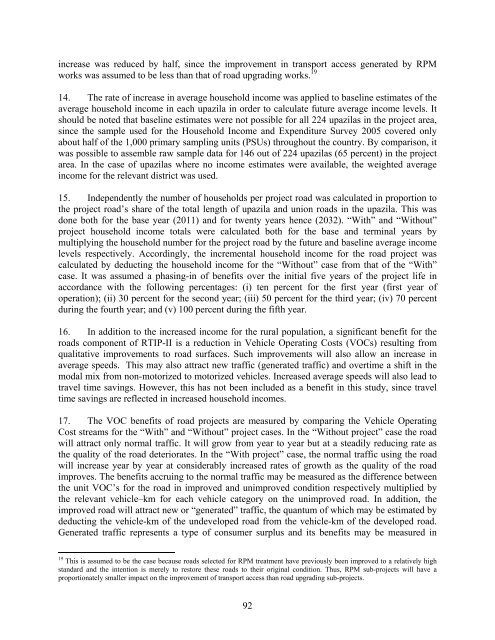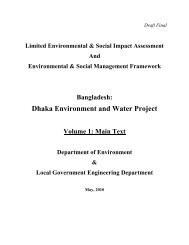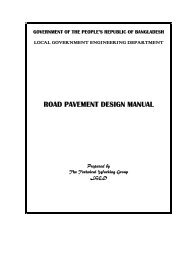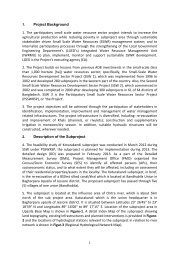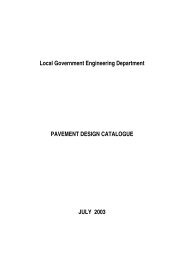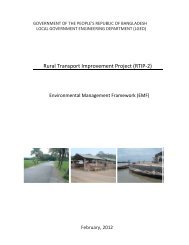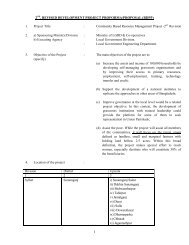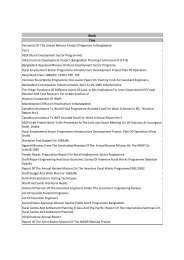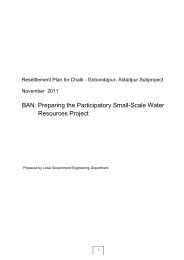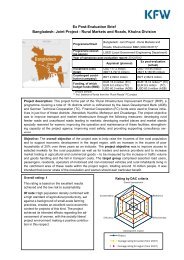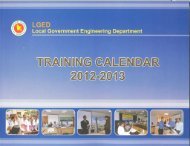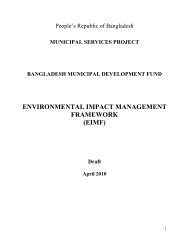PAD - LGED
PAD - LGED
PAD - LGED
You also want an ePaper? Increase the reach of your titles
YUMPU automatically turns print PDFs into web optimized ePapers that Google loves.
increase was reduced by half, since the improvement in transport access generated by RPM<br />
works was assumed to be less than that of road upgrading works. 19<br />
14. The rate of increase in average household income was applied to baseline estimates of the<br />
average household income in each upazila in order to calculate future average income levels. It<br />
should be noted that baseline estimates were not possible for all 224 upazilas in the project area,<br />
since the sample used for the Household Income and Expenditure Survey 2005 covered only<br />
about half of the 1,000 primary sampling units (PSUs) throughout the country. By comparison, it<br />
was possible to assemble raw sample data for 146 out of 224 upazilas (65 percent) in the project<br />
area. In the case of upazilas where no income estimates were available, the weighted average<br />
income for the relevant district was used.<br />
15. Independently the number of households per project road was calculated in proportion to<br />
the project road’s share of the total length of upazila and union roads in the upazila. This was<br />
done both for the base year (2011) and for twenty years hence (2032). “With” and “Without”<br />
project household income totals were calculated both for the base and terminal years by<br />
multiplying the household number for the project road by the future and baseline average income<br />
levels respectively. Accordingly, the incremental household income for the road project was<br />
calculated by deducting the household income for the “Without” case from that of the “With”<br />
case. It was assumed a phasing-in of benefits over the initial five years of the project life in<br />
accordance with the following percentages: (i) ten percent for the first year (first year of<br />
operation); (ii) 30 percent for the second year; (iii) 50 percent for the third year; (iv) 70 percent<br />
during the fourth year; and (v) 100 percent during the fifth year.<br />
16. In addition to the increased income for the rural population, a significant benefit for the<br />
roads component of RTIP-II is a reduction in Vehicle Operating Costs (VOCs) resulting from<br />
qualitative improvements to road surfaces. Such improvements will also allow an increase in<br />
average speeds. This may also attract new traffic (generated traffic) and overtime a shift in the<br />
modal mix from non-motorized to motorized vehicles. Increased average speeds will also lead to<br />
travel time savings. However, this has not been included as a benefit in this study, since travel<br />
time savings are reflected in increased household incomes.<br />
17. The VOC benefits of road projects are measured by comparing the Vehicle Operating<br />
Cost streams for the “With” and “Without” project cases. In the “Without project” case the road<br />
will attract only normal traffic. It will grow from year to year but at a steadily reducing rate as<br />
the quality of the road deteriorates. In the “With project” case, the normal traffic using the road<br />
will increase year by year at considerably increased rates of growth as the quality of the road<br />
improves. The benefits accruing to the normal traffic may be measured as the difference between<br />
the unit VOC’s for the road in improved and unimproved condition respectively multiplied by<br />
the relevant vehicle–km for each vehicle category on the unimproved road. In addition, the<br />
improved road will attract new or “generated” traffic, the quantum of which may be estimated by<br />
deducting the vehicle-km of the undeveloped road from the vehicle-km of the developed road.<br />
Generated traffic represents a type of consumer surplus and its benefits may be measured in<br />
19 This is assumed to be the case because roads selected for RPM treatment have previously been improved to a relatively high<br />
standard and the intention is merely to restore these roads to their original condition. Thus, RPM sub-projects will have a<br />
proportionately smaller impact on the improvement of transport access than road upgrading sub-projects.<br />
92


